
By now, modern businesses of all sizes know that a social media presence isn’t just “nice to have.” It’s essential for anyone looking to make a splash in almost any industry.
But to succeed in social media, you’ll need more in your tech stack than just social platforms. You’ll need to apply a few specialized social media tools to create and implement a winning social media strategy. They can help automate the process and make your campaign easier and more effective.
But what kinds of social media marketing tools do you need? How can then give you your best chance at making a splash in your industry? This article will explore several essential social media platforms, going in-depth on how to form the most effective social media tech stack possible.
Effortlessly export your Google Docs to WordPress with just 1-click.
Get Started Today
Simply put, you need social media management software because you’ll use different social media channels and social media marketing tools to run a well-rounded marketing campaign.
With the right tools, you can manage all social media profiles from a single‑task dashboard. For instance, planning and previewing an Instagram wall—the grid-style layout that shows your brand’s visual identity—becomes much easier. You can schedule, organize, and optimize all your posts in a unified calendar view. Doing so will allow you to schedule social posts in advance, track social engagement, determine your brand reputation, view campaign success, create relevant content, and more.
One of the primary reasons companies like yours need social media management tools is that you must remain consistent to generate traction.
That includes consistently responding to comments, consistently running targeted ad campaigns, consistently checking up on the public conversation surrounding your brand, and, most of all, consistently posting.
Consistent posting is pivotal in growing social media accounts and establishing a solid online presence.

An excellent example of this strategy in action is Fender, a brand renowned for its great craft for musical instruments and gear throughout the years. Fender has adopted a proactive approach by consistently posting across all their social media networks. By doing so, it’s cultivated a highly targeted user base that’s genuinely interested in its products.
But without management tools, they’d have to figure out the right time for publishing content on each social network. Then, they must create a separate social media post for each of them, all while tracking engagement and responding to comments constantly.
A strong visual identity is just as important as consistent posting when it comes to social media success. Recognizable branding through colors, typography, and well-designed visuals helps maintain a cohesive presence across different platforms. High-quality graphics enhance engagement and make content more visually appealing, whether for social media banners, infographics, or promotional posts. Since designing these elements manually can be time-consuming, many businesses use graphic design software to streamline the process, ensuring their posts maintain a professional and consistent look across various channels.
In some cases, even the best-designed content can suffer from blurry or unclear images, especially when repurposing older assets or user-generated content. That’s where tools to unblur images come in handy; they can instantly restore clarity and detail, helping maintain high visual standards without needing to recreate or retouch content from scratch.
Social media teams often find themselves working with screenshots, event photos, or visual posts that contain valuable text. This text can be anything from a quote, a customer review, or even product details. Instead of manually retyping that content for captions or repurposing, you could quickly pull the text directly from the image saving a lot of time. That’s where an image-to-text converter tool comes in handy, making it easier to reuse visual content efficiently across platforms.
Beyond scheduling and engagement tracking, branding plays a crucial role in a business’s social media success. A distinctive logo ensures instant recognition and credibility across platforms. With a logo maker, businesses can effortlessly create high-quality, professional logos that enhance brand consistency in every social media interaction—whether in profile images, banners, or branded content.
The tools we’re going to list below solve all of these problems.
Now that you understand why social media tools are so important, let’s review what tools you need in your tech stack. These are some popular tools used by marketing agencies worldwide.
The first and most important tool you should look into is social media analytics and reporting.
Why are analytics features and social media monitoring so vital?
While Google Analytics helps track KPIs and metrics on your website, it can’t monitor your social media channels. That’s why you need special tools to track social media insights.
Social analytics and reporting tools can provide insights into your social media audience.
When creating and scheduling posts on social accounts, you first need to know who they’re for. With a tool like this, you can analyze your marketing campaigns, engagement levels, and what the public says about you.
That’s some valuable insight because, without it, you’d be flying blind on all social channels. That makes social media planning all but impossible.

Using Keyhole as an example, you can use the platform’s range of features to:
For these reasons, an analytics and reporting tool for your social media campaigns will be necessary.
Content writing for social media can take up a lot of valuable time. While you could outsource relevant content to freelance marketing professionals, that’s an added cost you’ll have to work into your budget.
As social media managers, you want to have the best tools available while cutting costs on social content. So, if you can find a free tool that also helps you avoid a major expense, you’ve achieved a major win!
The AI writer can create social media captions, taglines, and copy for your posts in seconds. An Instagram caption generator helps craft engaging captions tailored to your audience. An online poster creator can also edit the preexisting templates with your brand logo and colors. Tools like these will optimize your work, producing quality daily posts per channel in the blink of an eye.
The more you use AI tools, the more effective they become. Even dictation software will eventually become accustomed to your voice and preferences.
By training your AI writing tool with the right prompts, you can ensure it generates the best results for you. Thanks to machine learning, these tools become even more useful the more you use them. Thanks to machine learning, these tools become even more useful the more you use them.
You’ll find that different social media platforms have different audiences and ideal post times.

As shown in the image above, posting schedules vary by platform. The ideal time to post on Facebook would be a Monday at 10am PST. On Instagram, you’ll get the most engagement an hour later. Twitter’s ideal posting time is the other side of the week, on Friday mornings. To make the most of these ideal posting times, it’s helpful to strategically use scheduled threads to plan and organize your content in advance. Schedule threads allow you to maintain consistency by lining up a series of related posts that unfold over time, keeping your audience engaged across multiple days or even weeks.
Without a social media scheduler, you’ll have to remember to log into those social media accounts every week, one at a time. That means being available at the specified ideal times and making each social media post.
However, using a social media scheduling tool like Planly can simplify this. Just create the posts in your dashboard and set them to post at the opportune time. You can set up all your social posts in bulk and put the entire process on autopilot. Automating your Instagram posts along with other platforms ensures your content reaches your audience when they’re most active, without you having to manually intervene.
For Twitter, you can even schedule threads, making it easy to share detailed, multi-part content at the ideal time without having to post each tweet manually.
You can do more with this powerful tool than just schedule posts. Additionally, a scheduling platform will allow you to create a social media calendar and monitor likes, comments, shares, and all forms of engagement.
You can even respond to Facebook comments, Instagram comments, tweets, and more right from one location without switching platforms endlessly. Postiz allows for seamless engagement across multiple channels, making social media management more efficient.
Social media schedulers are also great collaboration tools for scheduling content as a team for social media marketers in all industries.
Other team members can log in and view what’s going on. It’s then easy to make edits or add their own touch. Team collaboration for social media efforts is a must-have.
It’s crucial that you adequately protect your social media accounts. If a business social media account ever falls victim to a hacking attempt, it could be disastrous for your entire organization.
Someone with access to your business’s social media accounts could interact with your audience and get access to a wealth of company data. They could even make derogatory posts that could ruin your reputation.
That’s why you need to take security seriously.

One social media management solution you must implement is a reliable authentication system. Authentication is verifying the identity of your users and granting them access to your platform.
By protecting your social media accounts with a winning authentication system, you’ll be able to guard against attacks by hackers and other malicious cybercriminals. This extra step can help you achieve peace of mind.
While reliable authentication systems are essential for securing your accounts, it’s equally important to safeguard your connection. This is especially true when managing social media on mobile devices. Using a VPN for Android can add an extra layer of protection by encrypting your internet traffic. It also keeps your account credentials and activities private when working on less secure networks.
Besides securing your accounts, VPNs can also help ensure uninterrupted access to social media platforms, especially in regions where certain platforms may have restrictions. For instance, businesses or content creators relying on TikTok for audience engagement can use a VPN for TikTok to maintain access while safeguarding their online presence. This ensures that marketing efforts remain consistent, regardless of location-based limitations.
Your direct messages on social media can be an excellent way for your followers to contact you. It’s another channel they can use to get more information about your products or services.
By opening up this communication channel, you make your company more accessible to the average customer. But the main issue with this form of communication is that someone has to be on your end of the line to field customer questions and success.

Of course, that’s not always possible, especially as your company grows. That’s why businesses like yours are turning to the power of AI chatbots.
These automated systems run on artificial intelligence and can interact with members of your target audience like a human representative 24 hours a day, seven days a week.
That, in effect, gives you a 24/7 customer support system. This kind of accessible customer service is something that all businesses should strive for.
Of course, AI isn’t a perfect system yet. For the sake of the user experience, you wouldn’t want AI to have long, involved conversations with customers or try to handle advanced, delicate issues.
Instead, AI chat systems can engage on a basic level, answering frequently asked questions and sending knowledge-based information to potential customers. If your customer needs more advanced help, simply program the bot to let them know it’s escalating their request to a human representative.
Additionally, you could get by with a simple automated chatbot that doesn’t use conversational AI. This bot can directly respond to customer messages by thanking them for their time and interest. It can then let them know that someone will get back to them momentarily.
A social media management tool (also called a social media management platform) is a software solution designed to aid in or otherwise automate the functions of a business’s social media accounts. This can include scheduling posts, creating content, securing your social account pages, or generating analytics from your engagement and activity.
Social media management falls under three umbrellas. The first is the creation and publication of unique content. The second is monitoring the engagement driven on your posts. Finally, there’s their process of creating a community around your brand and helping that community grow.
A social media management tool is necessary for all businesses trying to leave their mark on social media. You can create, post, and schedule content with a social media management tool.
All businesses need a social media plan. Having a presence on social media platforms can make your business’s messaging more accessible.
Additionally, social media marketing efforts can open new possibilities for targeted advertising on platforms your audience frequents.
But you need social media tools to help you manage these different social profiles. If you want to succeed, you’ll need: